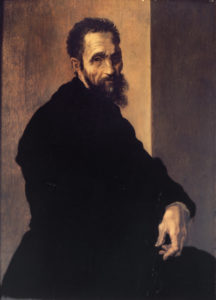
Michelangelo
In keeping with the saying “Rome wasn’t built in a day”, Rome is like a layer cake with monuments and art works dating from every period of history from 753 BC, when according to more than legend the Eternal City was founded by King Romulus, to the present. After living here for nearly half a century, if I came to Rome for the first time, I’d choose a sight from each epoch to give myself a full picture of Rome’s unique uninterrupted artistic time line that no other city worldwide can claim. For ancient Republican Rome, I’d go to the Forum; for Imperial Rome the Colosseum and Pantheon; for the Middle Ages the churches of Santa Prassede or of San Clemente; for the Renaissance The Sistine Chapel; for the Baroque St. Peter’s Basilica; for the 17th century The Spanish Steps; for the 19th century The Victor Emanuel Monument nicknamed the wedding cake or the typewriter; for the 20th century EUR, and for the 21st century Il Ponte della Musica or “Music Bridge” for cyclists and pedestrians and as of last month Marco Balich’s extravaganza: The Last Judgement: Michelangelo and the Secrets of The Sistine Chapel. For if Rome wasn’t built in a day, neither the Sistine Chapel, built between 1477 and 1480 by Pope Sixtus IV (reigned 1471-1484), for whom it was named.
The Chapel wasn’t painted in a day either. Its 12 wall frescoes were painted between 1481 and 1484 by the greatest painters of the day from Tuscany and Umbria summoned by the Pope to Rome. The frescoes depict parallel episodes from the lives of Moses and of Christ on opposite walls: Perugino’s Moses’s Journey to Egypt vs. his Baptism of Christ in the Jordan, Botticelli’s Moses Receiving the Call vs. his Temptations of Christ, Rosselli’s Crossing of the Red Sea vs. Ghirlandaio’s Calling of St. Peter and St. Andrew, Rosselli’s Adoration of the Golden Calf vs. his Sermon on the Mount, Botticelli’s Punishment of the Rebels vs. Perugino’s Handing Over the Keys to St. Peter, and Signorelli’s Last Day of Moses vs. Rosselli’s Last Supper. Originally there were two more frescoes: The Finding of Moses and The Birth of Christ on the wall behind the altar, but these were both destroyed to make way for Michelangelo’s Last Judgment.
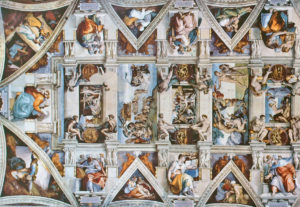
Ceiling of the Sistine Chapel
Several years later, after the papacies of Innocent VIII (reigned 1484-92) and Alexander VI (reigned 1492-1503), in 1508 Pope Julius II (reigned 1503-13) commissioned a reluctant Michelangelo (1475-1564), who had come to Rome from Florence to design and sculpt the Pope’s tomb, to paint the ceiling of the Sistine Chapel in addition. Michelangelo was unenthusiastic because he considered himself a sculptor and not a painter. Julius II convinced Michelangelo that he would be remembered for eternity for these ceiling frescoes, but not for just another papal tomb. So working alone from an especially built platform it took Michelangelo four years, until 1512, to complete the ceiling’s 33 separate images. Except for its Classical Sybils, painted because they were said to have prophesized the birth of Christ, the subjects are from the old Testament: God Dividing Light from Darkness, Creation of the Sun and the Moon, Separating Waters from Land, Creation of Adam, Creation of Eve, Original sin, Sacrifice of Noah, The Deluge, and the Drunkeness of Noah. “Michelangelo’s depiction here of God giving life to man is generally seen as a high point of the Renaissance that changed the course of western art,” wrote Philip Willan in his article, “Sistine Chapel Will Be Rejuvenated by Extravaganza of Special Effects”, published in the London Times on October 24, 2017.
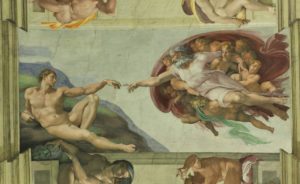
Creation of Adam
Then again three decades later in 1533 another patron Pope Clement VII (reigned 1523-34) commissioned Michelangelo to paint the wall behind the altar, which at the time centered around a painting of the Assumption of Mary by Perugino (a drawing of which is in the Albertina in Vienna). It took him from 1536-41 to paint.
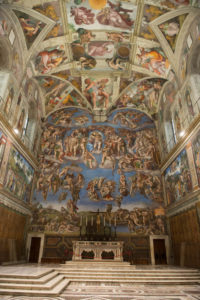
Last Judgment
Since March 15 and for at least the next year the story of the Sistine Chapel and of Michelangelo’s masterpieces is being recounted everyday except Good Friday and Christmas, sometimes three times a day, either in English or Italian, in a fantastic multimedia spectacle of special effects at the 1,500 seat Auditorium della Conciliazione on the Via della Conciliazione, the street that runs from the Tiber to St. Peter’s Square. The spectacle, which took three years to complete just like the Sistine’s ceiling, is called The Last Judgment: Michelangelo and the Secrets of the Sistine Chapel. It was produced by Marco Balich, a Venetian living in Milan who devised the opening shows of the Rio, Sochi, and Turin summer and winter Olympics. His company Artainment has rented the Auditorium for a year and hopes that Rome’s latest attraction will become a permanent one perhaps after a world tour. “We Italians,” he said at the press opening, “grow up with absolute privilege in terms of taste and art, so I decided to showcase the excellence of the Sistine Chapel. Millions of people, [supposedly 6 million per year,] visit it badly, in haste. The show promises to unveil the Chapel’s secrets. Here the viewers are enveloped by the paintings and admitted to the otherwise inaccessible conclave that elects the Pope.” The performances closest to this one that I’ve ever seen were the Christmas and Easter shows at Radio City Music Hall in New York City when I was a child.
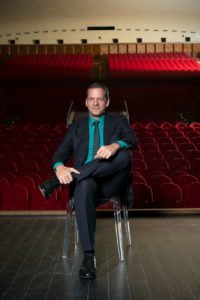
Marco Balich
Balich’s show, which cost $10.5 million and took three years to produce, lasts one hour and includes ballet, classy “Cirque du Soleil acrobatics, six live actors and one actress sometimes on stage and sometimes mingling among the audience, a soundtrack inspired by medieval sacred music and composed specifically for this project by the rockstar Sting, and video animation with 270° perspective of Michelangelo’s frescoes, of the conclave, and of St. Peter’s Square. With incense burning it thus stimulates every sense except touch.
I was invited by a PR company in Rome: Studio PuntoeVirgola to see it on March 22. As of that date over 40,000 tickets had already been sold on the web: www.giudiziouniversale.com or at the box office. The tickets cost from 18 at weekday non-evening performances to 28 euros for evening, weekend and holiday performances. Anyone under-26 pays respectively 16 and 18 euros and children between 5 and 13 years old 12 euros always. Headphones are available for 5 euros for translation in English, Chinese, Japanese, French, German, Portuguese, Russian, and Spanish. The Vatican will not make money from the ticket sales, but will profit from “contained” royalties from the performance.
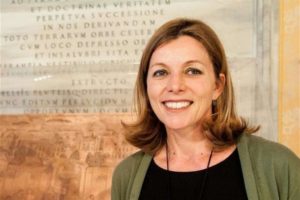
Barbara Jatta
Antonio Paolucci, a former director of the Vatican Museums, authorized the project in 2015 and his successor Barbara Jatta, director since January 2017, has also overseen its content. She said that the extravaganza provides an unparalleled educational opportunity to bring art, culture, and faith to younger technology-savvy audiences. It’s also an example of the Vatican’s attempt to modernize. Earlier similar such attempts were Leo XIII’s agreement to include photography in a 19th-century allegory he commissioned of “religion overseeing the arts” (he was the first pope to be filmed giving a blessing in 1896), and Pius XI’s early adoption of the radio (he founded Vatican Radio in 1931). As Elisabetta Povoledo wrote in her article “Bringing the Sistine Chapel to Life, with the Vatican’s Blessing”, published in the New York Times on March 12, “The Vatican has approved the project, on the condition that it would respect the artistic, religious and spiritual values that the Sistine Chapel embodies. Balich had to live up to that promise…The Vatican followed the process step by step. While it did not interfere with the creative aspects of the production, Vatican official kept tabs to make sure that the show’s content and references were historically accurate and did not stray from the righteous path.”
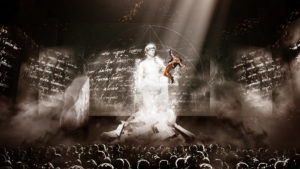
Michelangelo Sculpting “David”
The opening scene seems to simulate an earthquake with large blocks of grey marble cracking and crumbling. Instead the noise must be that of explosives in a marble quarry for in the next scene Michelangelo appears and starts carving his earlier masterpiece, the 17-feet tall statue of the Biblical hero “David”, which dates to 1501-4 and is housed in the Accademia in Florence.
The second scene shows the Chapel’s wall panels as they appear when a visitor enters the chapel and then each one, first one from the old Testament followed by its New Testament counterpart, is enlarged and floats through the air to encompass the viewer as if he or she becomes part of the scene. One such comparison The Eyewitness Travel Guide to Rome explains: In Punishment of the Rebels Moses was both spiritual and temporal leader of his people. He called down the wrath of God on those who challenged his decisions, thus setting a precedent for the power exercised by the pope. In Handing Over the Keys to St. Peter, Christ confers spiritual and temporal power on St. Peter…”
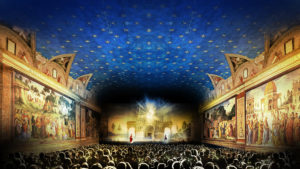
Balich’s view of the Sistine Chapel before Michelangelo painted the ceiling
The third scene shows Pope Julius II ordering Michelangelo paint the Chapel’s ceiling in spite of the artist’s protests. Once again the whole ceiling, the largest fresco ever painted, is reproduced overhead and then each of its nine central panel is enlarged and floats through the air for a closer viewing with audio side effects such as wind and rain for Noah’s Ark.
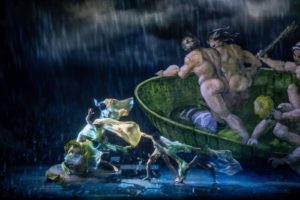
The Deluge
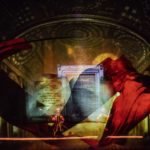
The Conclave
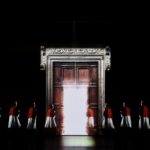
Procession of Cardinals Entering the Sistine Chapel for Conclave
The fourth scene is certainly the most dramatic and completely original as it recreates the funeral of Pope Julius II, reminiscent here of Pope John Paul II’s funeral with the pages of a Bible atop the coffin blowing in the wind. This is immediately followed by an animated video showing a facsimile procession of cardinals entering the Sistine Chapel for the conclave and then a reproduction of St. Peter’s Square and Bernini’s colonnade during a facsimile habemus papam ceremony.
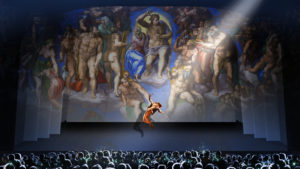
Balich’s “Last Judgment”
The fifth scene concerns Clement VII’s commission of “The Last Judgment” and the atmosphere and audiovisual techniques here are similar to those used for the ceiling with its scenes floating and enveloping the viewer. The robin egg’s blue of the fresco’s background, which became evident again after restoration (1980-94) and was criticized at the time as being too bright, makes each element of this wall stand out. The shows grand finale is a prelude written and sung by Sting and a 16-minute narration of the Chapel’s history and artistic influence approved by the Vatican.
I agree whole-heartedly with Dr. Jatta who said, after viewing Balich’s completed extravaganza a few days before it opened to the public: “It’s something extraordinary, never seen before. It’s not a documentary, but it has artistic and historical value. Obviously it doesn’t substitute for a visit to the Chapel itself, but it gives the viewer the same privilege that we technicians have every year when we climb up the scaffolding to inspect the frescoes’ conditions.”
I would take her comments one step farther; we can finally view the frescoes from the same viewpoints as Michelangelo while he worked. I see it as a unique introduction before a visit to the masterpiece itself. Buona visione!
If after the show you want respite and refreshment in surroundings that date to Michelangelo’s time from the Auditorium cross the Via della Conciliazione and head up the street toward St. Peter’s Square. In less than five minutes you will come to the entrance of Hotel Columbus, open to guests since 1950.
Its building was ordered by Domenico Della Rovere, Cardinal of San Clemente and the exceedingly rich nephew of Pope Sixtus IV, for whom the Sistine Chapel is named. The palazzo was frescoed by Pinturicchio (1452-1513), who may have helped his fellow-Umbrian Perugino to paint the Voyage of Moses and Christ’s Baptism in the Sistine Chapel and painted himself the two missing frescoes: The Finding of Moses and the Birth of Christ. Scenes from Sorrentini’s Oscar-winning film “The Great Beauty” were filmed in its elegant restaurant “La Veranda”, where it’s possible to eat outside in its torch-lit courtyard in good weather. Highly recommended are the pumpkin gnocchi with thyme, baby lamb stew, and artichokes however cooked. La Repubblica’s guide Roma Maxima rates its brunch one of the 10 best in Rome.
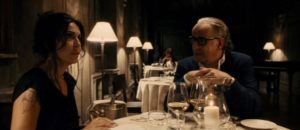
Scene from Sorrentini’s “The Great Beauty” at “The Veranda”
The Borghi or narrow cobblestoned streets behind the auditorium are full of small trattorie. Beware of tourist traps with a fixed price menu, so head straight to my favorite family-run Arlù in Borgo Pio for its Roman dishes and onion soup. Oh the desserts!
Instead if it’s trendy you’re after, continue on to Via Cresenzio and take a table at the romantic New York style bistrot and cocktail bar were Zanzara (meaning mosquito) for something light. There’s an ample menu of starters and pasta dishes, my favorite being tagliolino with shrimp, pecorino, and mint. If you’re feeling homesick, you can bite into an authentic pastrami sandwich or many types of burgers. You can even invent your own cocktail.
